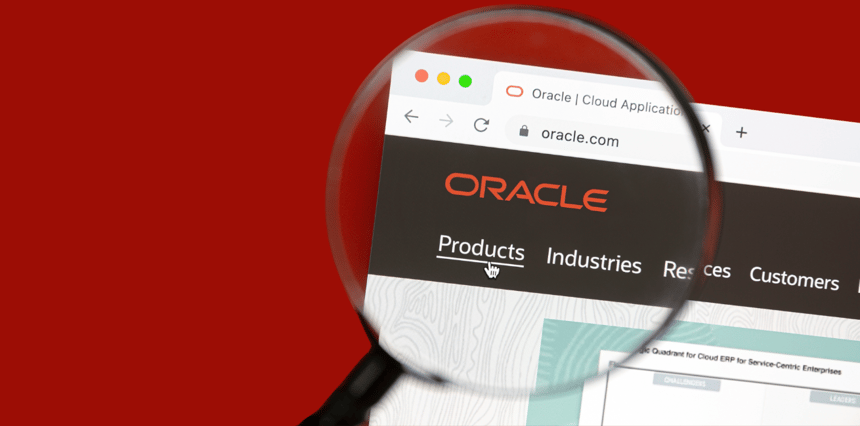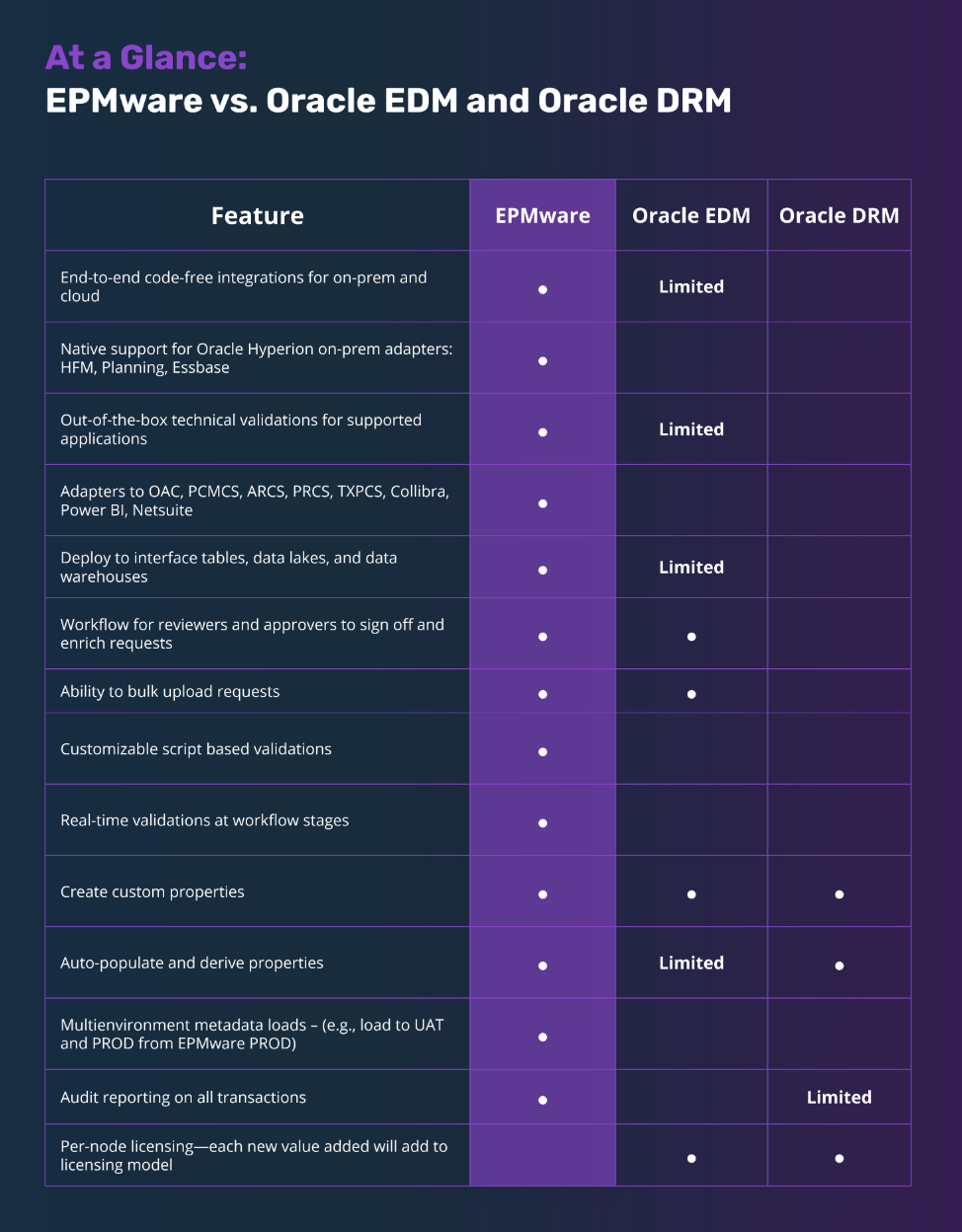
Oracle’s Enterprise Data Management (EDM) and Data Relationship Management (DRM) solutions are critical tools in your quest to maintain high-quality metadata, primarily for the Oracle Hyperion EPM application suite. Together, EDM and DRM provide three essential functions within the enterprise:
-
Adapt and respond to metadata changes in transactional and analytical systems.
-
Reconcile metadata differences across business functions and applications.
-
Build and retain consistency within master data asset systems.
Oracle EDM and DRM are two of the bigger names in the master data management marketplace when managing metadata for Hyperion applications. But some of the lesser-known solutions are worth comparing when searching for the best metadata management and data governance technology.
We’re about to show you how EPMware outperforms these industry leaders.
EPMware vs. Oracle EDM and Oracle DRM
Before we dive into this vendor comparison, it’s important to mention that, in some respects, we are not comparing apples to apples. Not because Oracle outranks EPMware in terms of size and brand recognition but because EPMware takes all of the best data management and governance features of Oracle EDM and DRM, adds additional capabilities, and puts it all into one easy-to-integrate, affordable platform.
EPMware manages metadata fundamentally differently from its competitors. What business users need two separate Oracle solutions to achieve, EPMware delivers in one unified metadata management and data governance platform that ensures your data is accurate, auditable, and trustworthy across every transaction in every application.
Let’s take a closer look at how EPMware stacks up against Oracle EDM and Oracle DRM.
The Contenders
Oracle Enterprise Data Management
Oracle EDM is a cloud-based centralized change management platform that allows users to align enterprise hierarchies, streamline change requests, and synchronize metadata across operational, financial, and reporting systems.
EDM is a relatively new addition to the Oracle EPM cloud landscape and has been adding functionality to create an on-par solution to DRM. Oracle has been recommending that customers move to EDM from DRM as they are actively moving to Cloud EPM applications such as PBCS and FCCS to replace on-premises planning and consolidation applications.
Oracle Data Relationship Management
Oracle DRM is an on-premise enterprise change management solution used to build and retain consistency within master data assets. Oracle DRM allows users to manage metadata changes across operational, analytical, and enterprise performance management silos.
DRM was introduced as the first master data management application meant to be a paid upgrade from EPMA for EPM on-premise applications. DRM support comes to an end in 2030, which means customers will have to move to another platform. DRM also requires the purchase of DRG in order to provide governance and approval capabilities.
EPMware
EPMware is a cloud or on-premise multidomain master data and data governance platform with built-in business application intelligence that makes managing hierarchies and data governance seamless. EPMware creates dimensional consistency across subscribing applications and captures approvals for centralized governance.
Comparing EPMware and Oracle EDM
On the surface, EPMware and Oracle EDM have a lot in common. Both are cloud-based master data and data governance solutions and connect disparate business applications, both streamline change management, and both can synchronize metadata across subscribing applications.
However, there are some significant differences between the two solutions:
Integration
Oracle EDM: Includes very few code-free integrations to all Hyperion and non-Hyperion applications in the cloud or on-premise. Systems integrators have mentioned that it is difficult to connect to and maintain custom integrations to on-premise applications to manage a hybrid MDM landscape. Cloud EPM applications are not plug-and-play and require flat file scripting to be developed, sometimes even requiring additional infrastructure to run EPM Automate programs.
EPMware: Comes with plug-and-play code-free integration to all on-premise and cloud Hyperion, OneStream, Anaplan, EBS, Fusion, and many of the most widely used EPM, CPM, and ERP technologies. Custom integrations using flat files and REST API calls are also supported.
Validations
Oracle EDM: Has a limited ability to write custom validations and derivations—think more “formula builder” using a dropdown menu than a free-form rules engine.
Additional menu items have been added since the early release, but migrating from DRM can be quite restrictive because many of the custom scripts in DRM cannot be translated using the formula builder.
The limiting nature of the formula builder has caused customers to adjust business processes to accommodate the lack of flexibility in the technology or simply hold off on a decision to move to the cloud.
EPMware: Lets you write custom logic in the form of scripts that can be used anywhere in the application by assigning them to configuration “events.” This allows for maximum flexibility to be able to customize validations, mappings, and workflows.
Migrating from DRM or EPMA becomes quite an easy task since the logic can easily translate into an EPMware logic script. EPMware logic scripts are also written in PL SQL, making it easy to maintain by any resource with light programming experience.
Licensing
Oracle EDM: Offers per-node/per-month pricing that can quickly add up to a seven-figure investment per year for managing metadata after the first 5,000 nodes.
EPMware: Offers enterprise licensing with unlimited nodes per managed technology. This model allows the entire technology to be managed in a hub-based model regardless of the number of nodes.
Comparing EPMware with Oracle DRM and DRG
Things get a bit more complicated when we compare EPMware with Oracle’s data governance capabilities. Oracle DRM is an on-premise master data management solution, and Oracle DRG is Oracle’s on-premise data governance solution, which is sold separately. EPMware offers both of these capabilities in one platform for one price.
Now, here’s the breakdown:
Master Data Management and Governance
Oracle DRM: You must purchase Oracle DRG in addition to Oracle DRM if you want to blend the experience of data governance capabilities with the ability to manage and share metadata.
EPMware: Unifies master data management and data governance capabilities into one platform. Users can opt to begin with master data alignment in EPMware and then add users to a workflow once an approval path is agreed upon by the business and IT.
Integration
Oracle DRM: Does not include code-free integrations to most Hyperion applications. Integrations to cloud applications may be difficult to achieve. Support for on-premise applications ends in 2030, so there is not much of a feature roadmap planned for this product. Most customers are advised to migrate to EDM on EPM Cloud.
EPMware: Includes out-of-the-box, plug-and-play integration adapters for all Hyperion on-prem and cloud applications as well as many other ERP and data warehouse applications. EPMware adapters also include commonly used validation scripts, which save a significant amount of time when integrating disparate technologies.
Integrations for hybrid landscapes (on-prem and cloud) are extremely common (e.g., HFM and PBCS). EPMware creates an easy and seamless integration to both on-prem and cloud offerings for a single source of metadata truth.
Scripting
Oracle DRM: Allows customers to write scripts to augment their custom configuration. However, the customers we have spoken with have found it difficult to find a migration path to EDM due to the complexity of their DRM scripts.
EPMware: Enables full flexibility to be able to write a business rule and apply it to configurable events, such as workflows, validations, imports, and exports. Customers have used scripting to derive metadata and property values, conditionally route workflow approvals, and even integrate EPMware request results with enterprise ticketing systems such as ServiceNow. Having the flexibility to write logic and leverage it in multiple different areas of EPMware allows for ultimate flexibility in configuration.
Licensing
Oracle DRM: Offers per-node pricing plus the cost of purchasing Oracle DRG if you want governance capabilities. With the on-premise suite support ending in 2030, customers will want to understand the roadmap of this product prior to making a large investment.
EPMware: Offers enterprise licensing with unlimited nodes and provides both master data management and data governance capabilities.
Recap: Where EPMware Stands Out over Oracle EDM and Oracle DRM
When you are considering EPMware, EDM, or DRM, it’s important to remember that all of these products are very capable of managing enterprise master data, yet they do so in fundamentally different ways.
In a side-by-side comparison, EPMware’s master data management and data governance capabilities are far more comprehensive and agile than Oracle’s. In short, with EPMware, you get more features, greater integration, better governance, and exceptional ROI, all in one unified solution.
Other considerations when you compare EPMware with Oracle EDM and DRM include:
Works in the Cloud or On-Premises
EPMware is available as an on-premise or cloud solution. Both offerings allow customers to manage cloud or on-premise metadata in one EPMware platform, giving users the flexibility to maintain a hybrid systems landscape (e.g., share metadata with HFM, PBCS and Snowflake).
Oracle DRG and Oracle DRM are both on-premise only. This is significant because Oracle is ending support for on-premise applications in 2030 and pushing that customer base to EDM Cloud. This has been difficult for DRM/DRG customers because EDM is not yet at parity with DRM/DRG to be able to manage complex business rules for validations and derived values.
Technology Agnostic
EPMware’s metadata and data governance capabilities are technology agnostic, so not only does it support the applications it has built-in adapters for, but it can also manage any other nonfinancial application metadata with ease.
Enterprise Licensing with Unlimited Nodes
EPMware offers enterprising licensing with unlimited nodes—unlike Oracle’s products that are priced per node/per month—except for a few very specific circumstances:
-
Oracle EDM Cloud is free if you’re using it with enterprise licensing for fewer than 5,000 nodes.
-
Oracle DRM is free if it’s replacing EPMA, but there are restrictions for Hyperion on-prem applications and interface table usage. Check out our detailed webinar outlining what you really gain or lose with DRM Lite when migrating to 11.2.x.
If you're curious whether EPMware is a good fit for your organization’s enterprise data management and data governance needs, or you would like to hear more about how EPMware stacks up to Oracle EDM and DRM in a side-by-side comparison, contact us or schedule a demo.
In a short 15-minute discussion, we can share detailed technical examples of why customers choose EPMware over EDM and DRM and demonstrate our capability in a free proof of concept.

